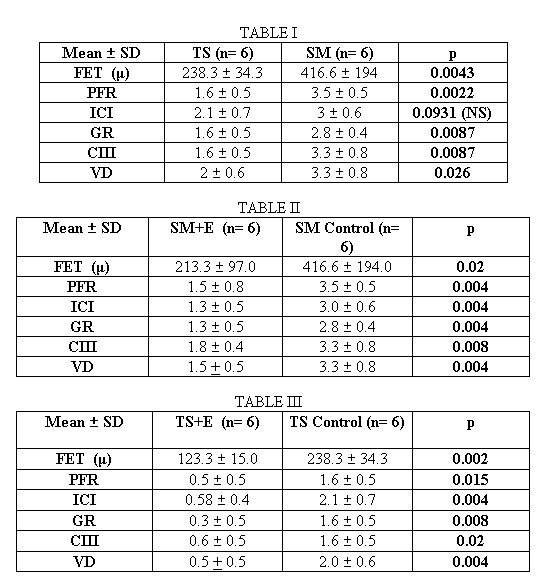Monday, November 4, 2002 - 4:54 PM
502
The Effects of Angiotensin-Converting Enzyme Inhibitors (Acei) on the Fibrous Capsule Around Mammary Implants
INTRODUCTION: During the last years different attempts were made in order to decrease the fibrotic reaction and avoid capsular contracture in breast augmentation. Pharmacological control is still unavailable essentially due to harmful side effects. The antifibrotic effect of ACEi is widely recognized in different tissues (kidney, lung, heart). The purpose of this study is to evaluate the effects of Enalapril (E) on the fibrous envelope around mammary implants in rats.
MATERIALS AND METHOD: Twenty-four mini breast prosthesis (supplied by Nagor GB Ltd., England) were implanted into 24 female Sprague-Dawley rats (250-300g.) (12 smooth=SM and 12 textured coating=TS) The rats were divided in 4 groups (G), each one: n=6. : G1: SM; G2: SM + E; G3: TS; G4: TS + E. Two months previous to surgery Enalapril (20 mg/L) was administrated in drinking water “ad libitum” in G2 and G4. All the rats were sacrificed three months after surgery and the fibrous capsules were evaluated by light microscopy (H&E; Masson’s trichrome and immunostaining by anti-collagen type III antibodies)
RESULTS: In this study fibrous envelope thickness (FET), pericapsular fibrous reticulum (PFR), inflammatory cell infiltrate (ICI), granulomatous rate (GR)around the envelope, collagen type III (CIII) and vessels density (VD) were consider under the Mann-Whitney test. FET is expressed in microns and the others are scored: 0=negative; 1=mild; 2=moderate; 3=severe; 4=very severe. Table I shows a significant difference between smooth and textured prosthesis. Table II analyze the effect of Enalapril treatment in smooth surface prosthesis. But the most significant results are shown in Table III, matching textured implants with and without Enalapril.
CONCLUSIONS: Enalapril, a known safe drug, and produces a significant reduction in the inflammatory process as well as a diminished vessels density in the fibrous envelope around breast implants. In addition textured implants showed less fibrous reaction than the smooth surface one. This experience shows that Angiotensin-Converting Enzyme Inhibitors can be a novel strategy for the reduction of the fibrotic reaction.

View Synopsis (.doc format, 133.0 kb)
See more of Breast (Cosmetic and Reconstructive)
Back to 2002 Complete Scientific Program
Back to 2002 Meeting home
